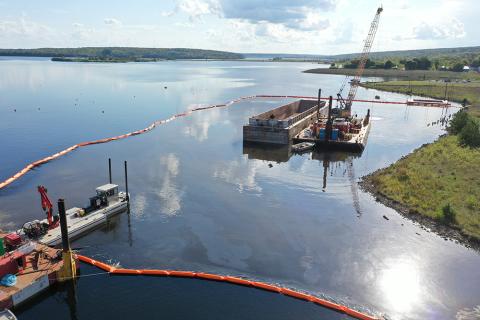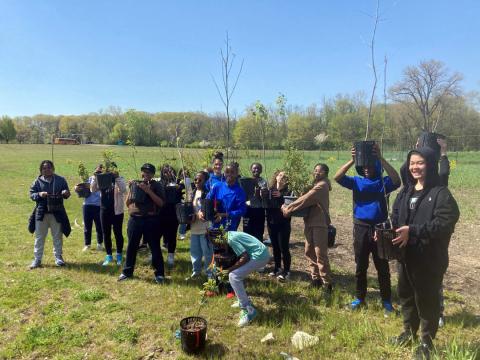Author: Cottage Life
EPA completes Drum Removal Pilot Study in the Hubbell Processing Area of the Torch Lake Area of Concern
EPA completes Drum Removal Pilot Study in the Hubbell Processing Area of the Torch Lake Area of Concern
josterme01
Wed, 11/13/2024 – 1:39 pm
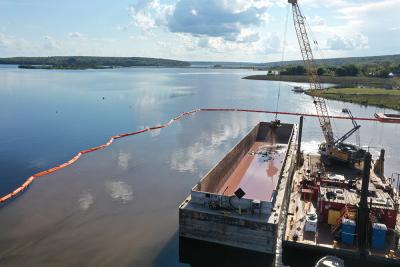
This fall the U.S. Environmental Protection Agency completed a Drum Removal Pilot Study in the Hubbell Processing Area (HPA) of the Torch Lake Area of Concern (AOC). The work was performed as part of the Great Lakes Legacy Act sediment and drum remediation as a partnership between EPA and Honeywell International, in close coordination with the Michigan Department of Environment, Great Lakes, and Energy and other community stakeholders.
As part of past evaluations and work performed by EPA and Honeywell, over 400 metal 55-gallon drums have been identified on the lakebed of Torch Lake in the HPA at various water depths, ranging from approximately 20 feet to over 70 feet in depth. Drums noted during underwater video surveys appear in various stages of deterioration with contaminated sediment present in the area of the drums.
EPA’s contractors removed approximately 100 drums as well as debris and contaminated sediment from three areas at differing water depths.
Turbidity curtains and bubble curtains, which help control residual sediment movement during dredging, were in place throughout drum and sediment removal operations. Extensive monitoring was performed during dredging activities that will help in the development of a larger cleanup project. Drums, debris and sediment removed were temporarily staged prior to be transported to a disposal facility.
The in-water portion of the pilot study was completed in late September with material transportation to the landfill completed in early November. The Drum Removal Pilot Study will assist in the evaluation of drum removal and cleanup options at various water depths, which is a critical component of the ongoing Torch Lake HPA Feasibility Study.
Learn more about remediation and restoration work in the Torch Lake AOC.
Great Lakes Commission Distributing Over $500,000 To Improve Management of Invasive Wetland Plant
Great Lakes Commission Distributing Over $500,000 To Improve Management of Invasive Wetland Plant
josterme01
Thu, 11/07/2024 – 12:46 pm
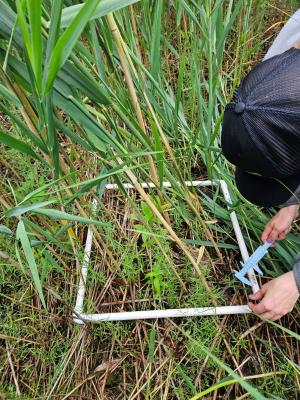
Over $500,000 of Great Lakes Restoration Initiative (GLRI) funding is being distributed by the Great Lakes Commission (GLC) through the Phragmites Adaptive Management Framework (PAMF) to improve management outcomes for treatment of the non-native Phragmites australis (common reed). Phragmites is a fast-growing non-native wetland plant species that has invaded much of the Great Lakes Basin. Phragmites can spread rapidly and outcompete native vegetation, thus contributing to landscape-scale ecological degradation. An extensive amount of time, effort, and resources are spent annually to control this problematic species, but site-specific guidance on best management approaches is still limited. To address this gap in management guidance, the Great Lakes Phragmites Collaborative (GLPC), a collaboration between the Great Lakes Commission, U.S. Geological Survey, University of Georgia, and other academic and management organizations, created and ultimately implemented the PAMF program in 2017.
PAMF is a participatory science program designed by the GLPC, including an interdisciplinary Science Advisory Team and Technical Working Group. The program uses Phragmites management data provided by land managers from around the Great Lakes Basin to help a predictive computer model “learn” about which Phragmites management approaches achieve the best outcomes. The model predicts which management actions will be most effective, and then each summer PAMF offers this guidance to participating land managers for the following year. The model outputs improve each year as incoming data characterize how the plant responded to the previous year of management. However, some management actions in the model are not widely used by managers and thus are underrepresented in the model. Therefore, a new Active Adaptive Management Program (AAMP) was initiated in 2024 to stimulate application and data collection of underrepresented treatment combinations, accelerate model learning, and improve management outcomes.
In March 2024, PAMF-AAMP released a request for proposals, through which land managers could apply for individual grants (most ranging from $5,000-$30,000) that provide the financial resources for testing specific management predictions. In September of 2024, the first round of individual grant recipients was announced, and management actions began shortly thereafter. For at least the next two years, AAMP participants will implement, monitor, and report impacts of specific Phragmites management actions that have fewer representation in the PAMF model data inputs. Results from this targeted AAMP program will be used to refine the PAMF predictive model and improve the effectiveness of future Phragmites management efforts.
Learn more about the Phragmites Adaptive Management Framework and the Active Adaptive Management Program.
Great Lakes Restoration Initiative grant improves soil, helps protect water quality in Ohio
Great Lakes Restoration Initiative grant improves soil, helps protect water quality in Ohio
josterme01
Tue, 10/29/2024 – 12:50 pm
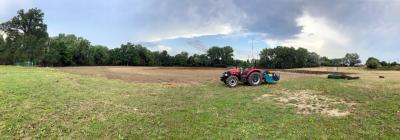
A $193,500 USDA Forest Service Great Lakes Restoration Initiative grant is helping maintain and improve water quality in Euclid, Ohio. The grant to Cleveland Metroparks is allowing partners to plant trees, reduce soil compaction and enhance a riparian buffer along Euclid Creek.
Cleveland Metroparks is the grant recipient and leads the project operations. The GLRI grant provided all the funding for the trees and herbaceous plants, plus rain gardens and deer fencing, and funds for the contractors to plant trees.
Euclid might not be a well-known community, but the nearby Cuyahoga River was once so polluted it made international headlines in the late 1960s through 1970s when it caught fire at least 14 times.
Teri Chuprinko, the USDA Forest Service grant monitor for the project, said the river has improved considerably since the ‘70s. “Today, the river can sustain fish and other wildlife. Organizations like Cleveland Metroparks are restoring riparian buffers and reducing stormwater runoff in the watershed to help maintain and improve water quality.”
The Euclid project is at the site of a former middle school with a sports complex that caused the soil to become heavily compacted after decades of being under the pavement and structures there. As part of the project, Cleveland Metroparks purchased a soil spader — still being put to use by cooperators on other projects around Cleveland — to decompact and amend the soil, which has been shown to greatly improve tree planting, survival and growth.
Great Lakes Restoration Initiative Emerald Shiner Fish Passage Project
Great Lakes Restoration Initiative Emerald Shiner Fish Passage Project
josterme01
Wed, 10/16/2024 – 3:07 pm
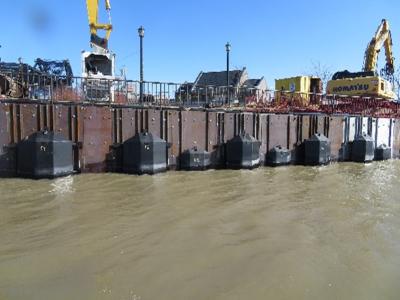
With funding from the EPA’s Great Lakes Restoration Initiative (GLRI), the US Army Corps of Engineers (USACE), Buffalo District, will build a 700-foot-long fish passage at the City of Buffalo’s Freedom Park on Unity Island. The emerald shiner is a small, but critical prey fish at the base of the food web in the Niagara River and Lake Erie. The high velocity of the Niagara River along the current seawall creates a barrier that the emerald shiners cannot pass to reach Lake Erie. Once the project is complete, the emerald shiner will be able to move upstream after spawning, providing a critical food source for larger fish and wildlife, offering sustenance for the local community, and contributing to goals for delisting the Niagara River as an EPA Area of Concern (AOC). The New York State Department of Environmental Conservation is the Niagara River AOC Remedial Action Plan Coordinator and with input from agencies and local partners, selected this project as a management action for the Loss of Fish and Wildlife Habitat Beneficial Use Impairment (BUI).
To reduce the river velocity along the seawall, a contractor will install steel plates, or metal baffles, within two feet above and below the typical waterline. In 2022, a demonstration project testing the effectiveness of this approach included the installation of the metal baffles along the most downstream 78 feet of seawall. Following installation, the USACE monitored the metal baffles for stability, reduction of water velocity, and to ensure the emerald shiner could pass. The demonstration project was deemed a success and lessons learned were incorporated into the design for the remaining portion of seawall.
The USACE Buffalo District recently awarded an $11.8M contract to complete construction of the remainder of the project, which will include repairs where necessary along the remaining 700 feet of seawall and the installation of the metal baffles. Construction is scheduled to begin late winter 2024 and be completed by December 2026. This will include both landside and in water work along the seawall. The improvements of passage for the emerald shiners will help to restore fish communities and contribute to removal of the Fish and Wildlife Habitat BUI.
To read the full announcement, please visit USACE Buffalo District.
EPA Announces $4 Million Funding Opportunity for Phosphorus Reduction Efforts in Western Lake Erie Basin
EPA Announces $4 Million Funding Opportunity for Phosphorus Reduction Efforts in Western Lake Erie Basin
josterme01
Fri, 09/27/2024 – 4:08 pm
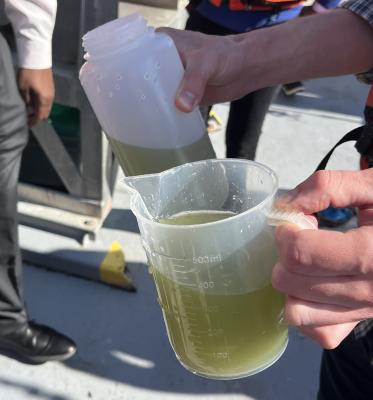
U.S. Environmental Protection Agency has announced the availability of $4 million in Great Lakes Restoration Initiative funding to support phosphorus reduction efforts in the western Lake Erie basin through farmer outreach and technical assistance. Applications will be accepted until November 22, 2024.
The western basin of Lake Erie experiences harmful algal blooms each summer. Reducing phosphorus loading from the surrounding watershed is expected to substantially reduce the extent of harmful algal blooms. The primary objective of this funding opportunity is to increase the resources available to help farmers improve their nutrient management.
Learn about eligibility, western Lake Erie Basin watershed definitions, application and webinar information on EPA’s 2024 Notice of Funding Opportunity webpage.








